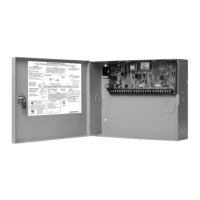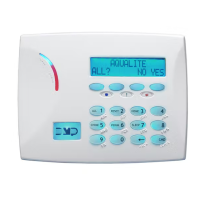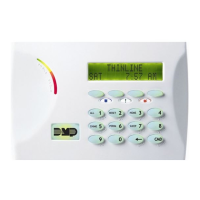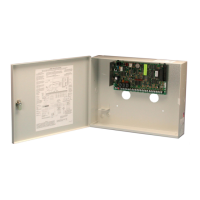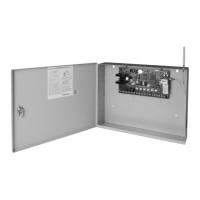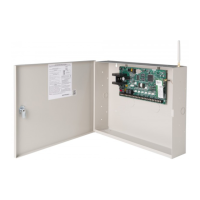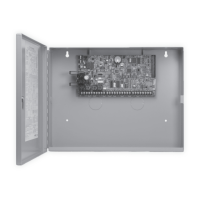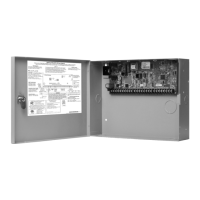
Do you have a question about the DMP Electronics XT Series and is the answer not in the manual?
| Brand | DMP Electronics |
|---|---|
| Model | XT Series |
| Category | Control Panel |
| Language | English |
Press NO or VERIFY to notify the emergency monitoring station. Your system will remain armed.
Press YES or CANCEL to cancel the alarm. Your system will disarm.
The control panel acts as your system's brain. It communicates with the keypad and all the other system devices throughout the building.
The keypad allows you to control your system from one place. You can use it to arm and disarm your system, add user codes, verify alarms, and many other functions.
A prox key is an impact resistant credential that fits on a standard key ring. It allows for codeless arming, disarming, and door access when it is presented to a reader.
Sensors are small devices that monitor motion, temperature, flooding, breaking glass, and know when windows and doors have been opened.
Depending on how your key fob remote is set up, it provides an easy way to arm and disarm your system or send a panic alarm.
The siren emits sound when your system goes into alarm.
These detectors notify you when smoke or carbon monoxide is present. Some detectors have an integrated synchronized sounder. If they are installed in groups, they will all sound simultaneously.
Details the LCD keypad, its proximity card reader, power/armed LEDs, and select keys for system operation.
Arms both perimeter and interior; use when no one is inside.
Arms just the perimeter; use when you're inside.
Arms the perimeter; use when you're inside.
Arms perimeter and part of interior; leaves bedrooms unarmed for night access.
Arms perimeter, interior, and bedrooms; use when no one is inside.
Explains the function of the CMD key for navigating user menus and saving information.
Describes the use of the back arrow key for navigating menus and erasing characters.
Details how select areas on the keypad display functions and options, and how to navigate them.
Explains the layout and usage of the standard keypad keyboard for entering text and numbers.
Describes an Area system where protection is divided into up to six custom-named areas with access control.
Explains the All/Perimeter system divided into two main areas: All (perimeter and interior) and Perimeter (only perimeter).
Details the Home/Sleep/Away system divided into 2 or 3 areas: perimeter, interior, and bedrooms, with specific arming modes.
Steps to arm an Area system using the keypad, including options for arming all or selected areas.
Instructions for arming an All/Perimeter system, choosing between arming all areas or just the perimeter.
Steps to arm a Home/Sleep/Away system, selecting Home, Sleep, Away, or Guest modes based on occupancy.
How to instantly arm the system, overriding entry and exit delays for immediate arming.
Instructions on how to bypass zones that have issues, reset bypassed zones, or stop the arming process.
Procedure to extend an active schedule to a later time when arming the system.
Steps for handling alarms, distinguishing between real and false alarms and notifying the monitoring station.
Instructions to disarm the system using the keypad, including options for disarming all or individual areas.
How to arm the system using a key fob button and understanding the LED acknowledgement signals.
How to disarm the system using a key fob button and interpreting the green LED acknowledgement.
Provides a list and brief explanation of all available options within the User Menu.
How to activate a pre-programmed Favorite function from the system menu.
Procedure for adding a new Favorite, including assigning a number and name to Z-Wave devices.
Procedure for adding new Z-Wave devices to the system, including naming and saving them.
How to rename existing Z-Wave devices within the system for easier identification.
How to check the communication status of Z-Wave devices and remove failed devices.
Steps for connecting the system to a Wi-Fi network using the WPS pairing method.
How to view available Wi-Fi networks and connect to a desired network.
Procedure for manually connecting the system to a Wi-Fi network by entering network name and password.
Instructions for testing the Wi-Fi network connection status and confirming connectivity.
Guidance on weekly testing of burglary protection by using Zone Monitor mode to confirm sensor operation.
Explains user numbering from 1-30 (XT30) or 1-99 (XT50) for system identification.
Details the 4-digit user code for arming/disarming, kept secret from other users.
Describes programming user names (up to 16 characters) and assigning authority levels (Master, Standard, etc.).
Details on setting up permanent schedules for automatic arming/disarming that occur at fixed times.
How to extend the time for a closing schedule to expire.
Procedure to add a new output schedule, specifying output number, days, and ON/OFF times.
How to add schedules for outputs based on sunrise or sunset times, with adjustable offset times.
Steps for adding a schedule to a Favorite, specifying the favorite number, day, and activation time.
How to add a schedule to a Favorite based on sunrise or sunset, with offset options.
Explains the 'INVALID CODE' message and how to resolve it by checking the entered user code.
Describes the 'CLOSING TIME' message, reminding users to arm the system or extend the schedule.
Explains the 'AC TROUBLE' message indicating no AC power and advises contacting a service person.
Explains the 'BATTERY TROUBLE' message indicating a low or missing battery, advising to contact a service person.
Indicates a problem with system components and advises contacting a service person.
Explains the 'SYSTEM BUSY' message, advising to wait or contact a service person if the issue persists.
Describes '4-WIRE BUS TROUBLE', indicating issues with supervised devices or wiring, and advising to contact a service person.
Explains 'TRANSMIT FAIL' indicating communication failure with the central station, advising to check the phone line.
Explains 'NON-POLLED ADDRESS' indicating an invalid keypad address, advising to contact a service person.
Explains 'WIRELESS TROUBLE' indicating communication issues with the wireless receiver, advising to verify connections.
Indicates a low battery for Z-Wave Lock devices, advising to contact a service person.
Explains 'ZWAVE BUSY' when multiple keypads access Z-Wave setup, advising to exit from one keypad.

